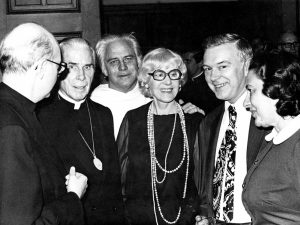
When I was in graduate school at CUA in the 1990s, I came across the name Fulton Sheen while studying American Catholic culture in the twentieth century. I learned that Sheen taught Sacred Sciences and Philosophy at CUA from the 1920s through the early 1950s, wrote dozens of books and pamphlets, and that he was an extremely popular speaker on the National Council of Catholic Men’s Catholic Hour. These fit with my understanding of a charismatic Catholic priest of the twentieth century. Then I learned that Sheen had won the 1952 Emmy for “Most Outstanding Television Personality,” beating out Jimmy Durante, Lucille Ball, and Edward R. Murrow. I thought: huh?
I figured I’d ask my mom if she’d ever heard of him. After all, she grew up Catholic in the 1950s and watched television, had she seen him when she was growing up? I was unprepared for her emotional response. “Oh, I loved Fulton Sheen. I watched Life is Worth Living every week!” I asked her what she liked about him. “I thought he was very saintly. He was mesmerizing when he talked, and he had this stare. His sermons were very deep. My faith was stronger after I listened to him.”
Sheen biographer Thomas C. Reeves notes that Life Is Worth Living went on the air “at the right time, for the 1950s marked a golden age for American churches.” Polls bore this out: in 1952, 75% of Americans told pollsters that religion was very important to them, and five years later, 81% said they thought religion could answer all or most of life’s problems.¹

Nonetheless, few thought Sheen’s show would succeed: when he first went on the air in 1952 he was set up against Milton Berle (known as “Mr. Television” at the time) and Frank Sinatra in what was known as “an obituary spot” at 8 p.m. as it was believed that no one could compete with those two famous personalities. One agent called Sheen “a dead duck.” Take a telegenic and charismatic Catholic evangelizer like Fulton Sheen to this national mood and you get an entire generation of American Catholics with fond spiritual memories of one of the popular religious shows of its time—Sheehan drew many millions of viewers a week.²
Life is Worth Living didn’t run original episodes for long. Starting on the Du Mont network in , the show ran from 1952-1955, when ABC picked it up and ran it until 1957. The show went into syndication, though Sheen starred on other programs until 1968. And many Catholics of a certain age will remember him with affection, as does my mother.

In addition to pioneering in religion and media, Sheen served in several positions of authority within the church. Known for his evangelical abilities, he was named the national director of the Pontifical Mission Aid Societies in the United States and auxiliary bishop in New York at the behest of Cardinal Spellman, the city’s archbishop. With this appointment, Sheen resigned from the faculty of CUA. This mission was one of the largest sources of funds for the Vatican missions, and under Sheen’s guidance as director, donations from America dramatically increased. Pope Paul VI named Sheen as the bishop of Rochester on October 26, 1966, a position from which he resigned three years later. He continued writing and speaking in New York City until his death in 1979. By the end of his life, he had published sixty-six books and sixty-two booklets, pamphlets and printed radio talks. Sheen died on December 9, 1979 before the Blessed Sacrament and was buried in St. Patrick’s Cathedral beneath the altar.
The archives holds several collections of materials related to Fulton Sheen:
- The Sheen papers are reflective of Sheen’s time at CUA and his work with the Second Vatican Council.
- The Bishops Conference records contain Catholic Hour materials in which Sheen was heavily involved
¹Thomas C. Reeves, America’s Bishop: The Life and Times of Fulton J. Sheen (San Franciso: Encoutner Books, 2001) 229-240.
²Thomas C. Reeves, America’s Bishop: The Life and Times of Fulton J. Sheen (San Franciso: Encoutner Books, 2001) 229-240.
